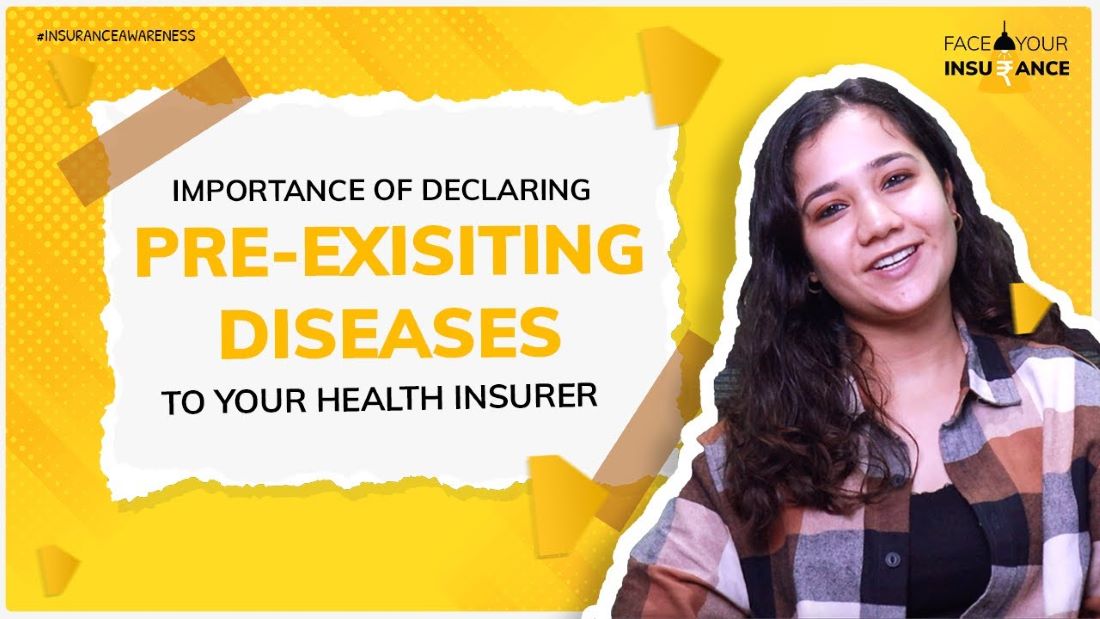Buy Health Insurance, Up to 20% Discount
9000+
Cashless Hospitals
2.5 Crore+
Lives Insured
4.5 Lacs+
Claims Settled
I agree to the Terms & Conditions
Get Exclusive Porting Benefits

Buy Health Insurance, Up to 20% Discount
Port Existing Policy
9000+
Cashless Hospitals
2.5 Crore+
Lives Insured
4.5 Lacs+
Claims Settled
What is Pre Existing Disease Cover in Health insurance and How Does It Work?
Some of us carry a bit of medical history with us, whether it's a past surgery, an old injury, or a long-term condition like diabetes or hypertension. These are known as pre-existing diseases. But is there any medical insurance for pre existing conditions?
Yes, and understanding what qualifies as a pre existing disease and how it works in your health insurance policy can save you from emergencies later. Let’s explore PED in health insurance.
What is a Pre-Existing Disease?
Once you know the full-form, it sounds a lot simpler! PED stands for ‘Pre-existing Diseases’ or Pre-existing Condition, and is an important factor in your health insurance. It basically refers to the diseases or ailments you were suffering from at the time you bought your policy.
According to IRDAI, a “pre-existing disease” in insurance is any illness you were suffering from and diagnosed with 36 months before you bought your health insurance policy.
PEDs can range from serious medical conditions like cancer or diabetes to ailments like blood pressure or allergies.
So, imagine your doctor diagnoses you with asthma and writes you a prescription for asthma medication, and you buy insurance one year later. Then, your health condition – that is, asthma – is a pre-existing condition.
Importance of Pre-Existing Disease Coverage in Health Insurance
Pre-existing disease coverage is a lifeline in health insurance, ensuring that your past health conditions don't drain your finances. Here are some reasons why having pre-existing coverage is important:
List of Pre-Existing Diseases in Health Insurance
The list of pre-existing conditions that are included in health insurance plans are:
Tuberculosis |
Renal Cyst |
Diabetes |
Arthritis |
Varicose veins |
Cataract |
Dengue |
Hepatitis |
Blood Pressure |
Heart Disease |
Bronchitis |
Thyroid Disorder |
Hernia |
High Cholesterol |
BMI |
Asthma |
Epilepsy |
Sclerosis |
Disclaimer: The above conditions are a general representation of PED. Coverage and exclusion for these conditions may vary depending on your health insurance policy. Please read your policy document thoroughly to understand the coverage.
Why is it Crucial to Disclose Pre-Existing Disease Before Buying Health Insurance?
You may be wondering if it’s worth declaring your pre-existing condition in the first place. But in this case, it’s best to be as transparent as possible!
Why?
If you hide your pre-existing condition from your insurance provider, they will find out about it later. They may not cover it at all. So, it’s better to wait a while and get your PED covered than not declare it! Go through your medical files to ensure you have included all the diseases and treatments you would need to be covered.
Importance of Declaring Pre-Existing Disease

Do you think hiding your pre-existing disease won’t affect your insurance?
Think again! Not disclosing a pre-existing disease can lead to cancelling your health insurance policy. So, transparency is key to avoiding claim rejections and policy cancellations. Watch the video to know the importance of declaring your pre-existing disease to your insurer.
What Happens When You Don’t Disclose Your Pre-existing Disease?
When purchasing health insurance, if you fail to disclose a pre-existing condition (PED), you run the risk of having your policy cancelled and facing additional penalties, such as:
- Refusal of Claim: Your insurer can reject a claim you make for a disease you did not disclose.
- Limitations on Coverage: Your coverage could be restricted even if your claim is accepted.
- Policy Cancellation: Your insurer can cancel your policy if you deliberately hide a pre-existing disease.
What is the Waiting Period for Pre-existing Diseases in Health Insurance?
Most policies include pre-existing condition insurance, but there is a waiting period in health insurance of a few years before the condition is covered. The number of years depends on your age and your condition.
The waiting periods for pre-existing diseases typically range from 1 to 3 years, depending on your health insurance provider and the kind of plan you select.
Types of Waiting Periods in Health Insurance Policy
So, what are these waiting periods we were talking about? Well, there are actually a few different types of health insurance. Let’s go through some of the most common ones:
Disclaimer: The above-mentioned waiting periods are the standard durations provided by insurers across the industry.
How Pre-existing Disease Work in Health Insurance?
Understanding how pre-existing diseases work in health insurance is crucial for staying protected from financial burdens in future. Here is a breakdown of how pre-existing diseases work in health insurance:
Buying Health Insurance
Buying a health insurance policy with PED coverage is a crucial first step in safeguarding your financial future. You can buy the plan as per your specific needs.
Mandatory Declaration
When buying a health insurance, it is essential to disclose any pre-existing disease to your insurance provider. It includes any illness you suffered and diagnosed with 36 months before buying your insurance policy.
Medical Tests & Diagnosis
Insurers may ask for medical tests before offering you coverage to assess the risk of insuring you with a PED condition. Based on your diagnosis test results, your insurer will decide the premiums, coverage and sum insured in health insurance.
Impact on Premiums
Health insurance policies covering PEDs often come with higher premiums. Insurers assess the increased risk of covering an individual with an existing condition, which may result in a higher cost. The premium is decided based on your disease and coverage.
Get to know: How to calculate the Health Insurance Premium?
Waiting Period for Coverage
Most insurance policies impose a waiting period for pre-existing diseases, typically 1 to 3 years. This waiting period differs from policy to policy. During this period, claims related to PED are not covered, but claims related to any other problems, such as accidents or illnesses (as per your policy), can be covered.
Coverage After Waiting Period
Once the waiting period is over, the health insurance policy covers treatment costs for pre-existing diseases incurred after the waiting period. The coverage will depend on your policy terms and conditions.
Claim Settlement
If the waiting period is over, claims related to PED expenses encountered after the waiting period may get approved as per the policy’s coverage limits.
Non-Disclosure Risks
If pre-existing conditions are not declared at the time of policy purchase, they may lead to claim rejections even after the waiting period is over.
How Does Pre-Existing Disease Affect Health Insurance Policy?
Things You Should Know about Pre-Existing Conditions in Health Insurance
These are some crucial details about pre-existing conditions in a health insurance that you should be aware of:
Health Insurance policies differ from one another
And so do the terms and conditions with respect to pre-existing conditions. You should always check for waiting periods and the list of PEDs that are covered by your health insurance policy.
Not all ailments are considered pre-existing conditions
Not all ailments or visits to the doctor are considered as pre-existing conditions. Insurers only consider medical conditions and ailments that have had a long-term effect on a person’s health.
Hiding a Pre-existing Condition is never a good idea
We often think we should hide the facts that might hinder our chances of getting health insurance, like a pre-existing condition. However, this can lead to a reverse effect, where even if you get a health insurance policy by hiding a PED, your claim might get rejected.
You can get coverage for Pre-existing Medical Conditions
We often think that PEDs cannot be covered. However, various health insurers offer the benefit of a "Waiver of Pre-existing Condition" that covers PEDs and covers expenses related to them.
Waiver of Pre-existing Disease has a waiting period
For your health insurance policy to cover PEDs, often insurance companies have a waiting period of 2 years. So, you should start early with your health insurance policy.
Your health insurance provider may reject your claim if you have a pre-existing condition
But if you get a waiver of PED cover, your pre-existing conditions will also be covered in your policy. Most insurance providers have a 1-3 year waiting period for pre-existing conditions. This means that you’ll have to wait that long for your insurance provider to start covering your PED!
Why Claims Get Rejected for Non-disclosure of Pre-existing Disease Post-Waiting Period?
When a person doesn't disclose their PED to their insurance provider at the time of purchasing an insurance policy, it is considered as non-disclosure of pre-existing disease (PED). In such cases, the claims get rejected, or your insurer might apply a limitation on the coverage.
For example, Mr. Rutvik bought a health insurance plan in 2021 with a 3-year waiting period, and he didn't disclose his blood pressure problem.
Later, in 2025, Mr. Rutvik was hospitalised due to high BP and thought that his insurance company would cover the cost as the waiting period was over. However, his claim was denied since he had a PED and did not report it at the time of purchase.
Do’s and Don’ts for Pre-Existing Disease
The key to grasping each information about PED is by knowing what to do — and what to avoid. Let's review some crucial rules for choosing health insurance for pre-existing conditions.
Hence, it is essential to disclose any PED at the time of purchasing the health insurance policy to avoid any future claim rejections.

Explain it like I'm five
We're making insurance so simple that even 5-year-olds can understand it.
A cycling competition is held in school. All the students that sign up for the competition are told to go through a medical check-up first. One student is found to have sprained his ankle 10 days ago. So, the school tells him that he cannot participate in the competition this month – but he can come back and participate next month. That’s because the student had a Pre Existing Condition!















